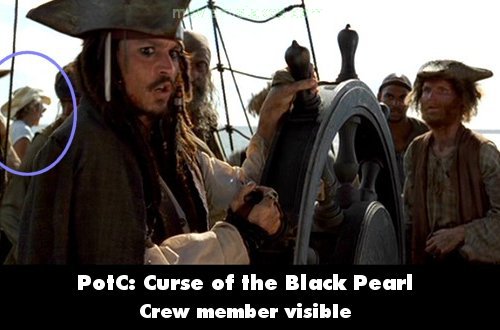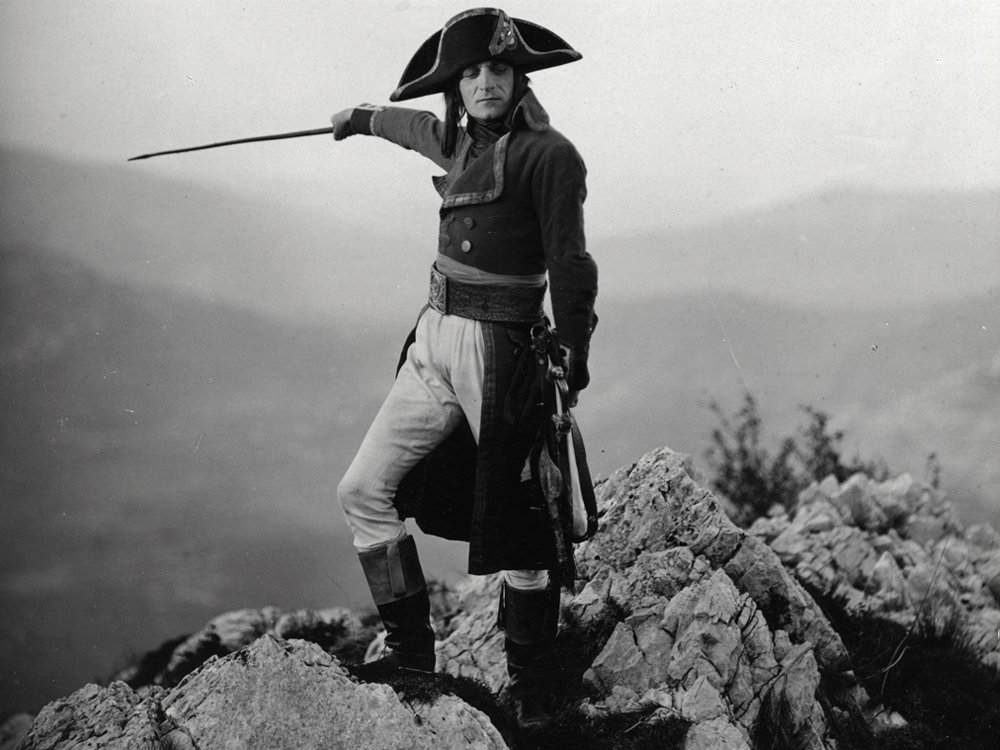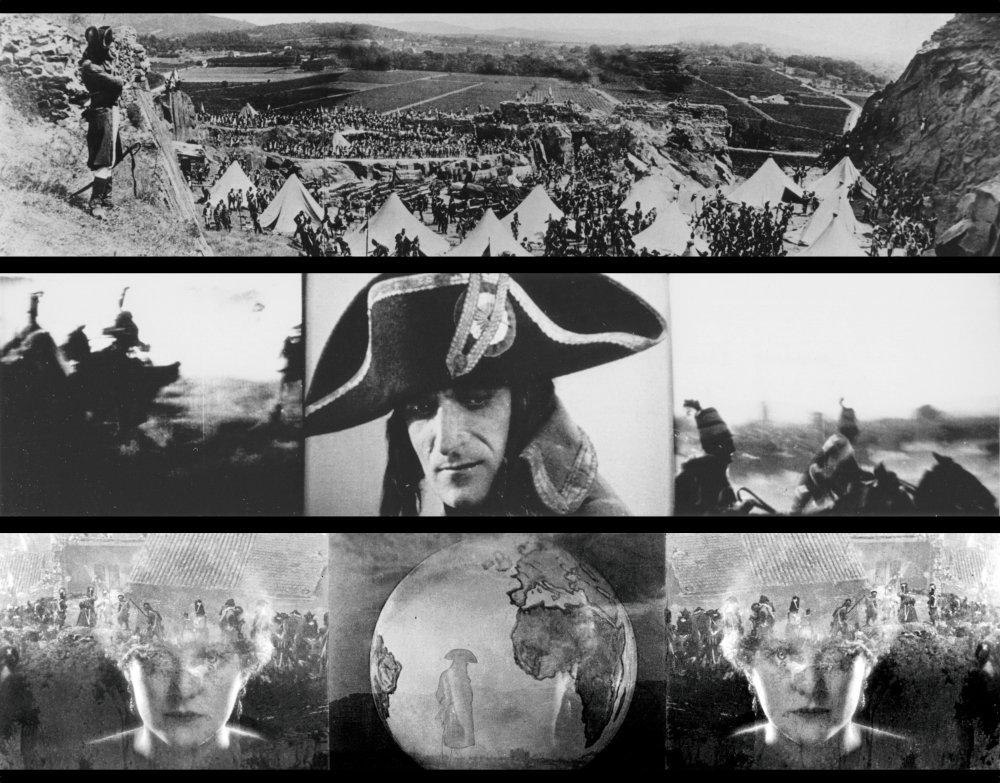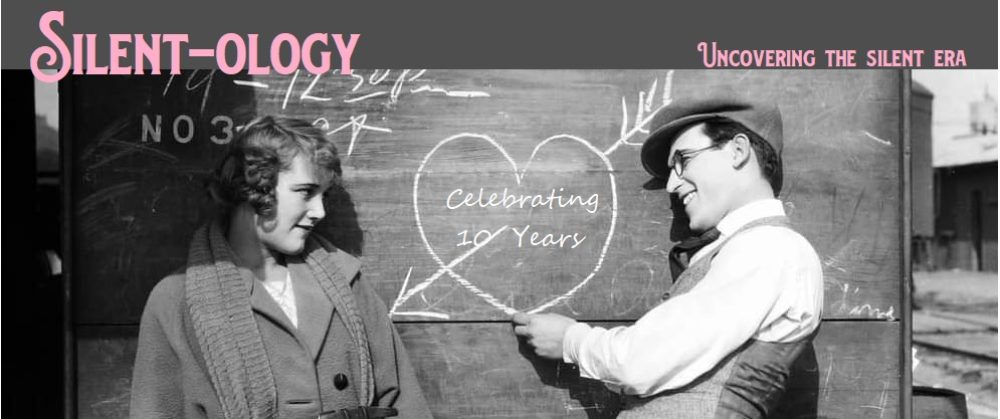This is my own post in honor of the Silent Movie Day Blogathon. Hope you enjoy!
When it comes to talking about great movies (in the Roger Ebert sense of the word), I’ve always loved making and sharing lists: top tens, top fives, your “essential threes”–they always seems to prompt interesting discussions. Face it, you’re asked to list what you think are the Top 10 Best Movies Ever Made and it’s hard to resist, isn’t it? Even the top film critics and directors in the world famously contribute to Sight & Sound‘s “Top 10 Greatest Films” lists once every decade. It’s enlightening to see how certain films will fall a bit out of favor while others remain universally praised–often for generations.

But your average carefully-compiled lists, hard as they can be to put together, are one thing. Trickiest of all is picking a single “greatest of the great” film from a given genre or era (putting aside the immense difficulty of choosing “The Greatest Film, Period”–phew!). So with that in mind, and since no one asked me, I thought I’d ponder: “What is the greatest silent film?”
First, what do we mean by “greatest”? Many people seem to equate “greatest” with “the most perfect,” but I don’t know if that should be–or technically can be–the case. Even the most precisely designed prestige pieces by the most manically obsessive, jackboot-wearing directors are going to have a flaw or two. Maybe part of the plot doesn’t make sense, maybe there was a continuity mistake, maybe an extra wandered into the frame eating a sandwich, etc. So let’s agree that “absolute perfection” isn’t necessarily the most ironclad criteria for World’s Best Silent.

So what contenders spring to my mind right away? Three in particular: Intolerance (1916), Napoleon (1927), and Sunrise (1927). I’d pick one of those three.
![Intolerance | film by Griffith [1916] | Britannica](https://cdn.britannica.com/64/59664-050-E5CA04C8/temple-sequence-Babylon-Intolerance-DW-Griffith.jpg)
Intolerance is already legendary for the sheer scale of some of its scenes, specifically the grand set of Belshazzar’s Feast with its 90-foot walls. The genesis of this mighty epic was humble enough: D.W. Griffith had been looking to improve a small drama called The Mother and the Law starring Mae Marsh and Robert Harron. Naturally this was expanded into a multi-hour megapicture cutting among four dramatic stories set in various times and places, united by the theme of “intolerance.” Griffith had been smarting about the criticism of his Civil War blockbuster The Birth of a Nation (1915), so “intolerance” was certainly on his brain. For viewers today, it’s also a theme that with more universal interest than the controversial plot of the former.
Experimental films weren’t uncommon in the silent era (especially in Europe), but in my opinion the scale and ambition of Griffith’s film had never quite been matched. It’s rightly been criticized for the imbalance of its stories–sometimes you forget the French story exists–and its length can be a difficult sell, but it’s hard not to respect its intentions. The extreme long shot of Belshazzar’s hall with its floating camera was a milestone, and Griffith’s montage near the end as the four stories reach their dramatic climaxes was certainly ahead of its time. Other directors–like Eisenstein or Able Gance–would use montage more effectively, but Griffith was their inspiration. Soviet directors poured over prints of Intolerance to figure out its editing secrets. Gance was later inspired to emulate–and try to top–Griffith, who he strongly admired. And speaking of Gance…

It’s not for nothing that legendary historian Kevin Brownlow has been a decades-long champion of Abel Gance’s Napoleon (1927). Another mega-epic with a Griffith-level scale, it used every remarkable camera effect in the book and ultimately leapt from the confines of the frame and played with the format of the movie screen itself.
The Parisian-born Gance strongly believed that films didn’t need to just go from plot point to plot point, but could tell deeply psychological stories. Firmly believing cinema was “in a rut,” by the mid-1910s he was already experimenting with unusual camera angles and closeups and was trying to use metaphors whenever he could. After building his reputation with artistic features like WWI drama J’accuse (1919) and La Roue (1923) with its stunningly fast montages, he would top everything with his sweeping feature about the life of Napoleon Bonaparte.

Gance pulled out all the stops, suspending the camera from wires or mounting it on pendulums, using special wide angle lenses, playing with iris shots and gauzes, editing fast-moving montages, using multiple separate exposures in the same frame (up to nine scenes in one!), etc. And most fascinating of all, he decided to invent Polyvision, a type of widescreen using three conjoined screen for a triptych effect. The three screens could show one panoramic shot or three separate scenes, which he would link thematically–one of the most famous sequences showed two swaying shots of a rioting crowd interspersed with one of Napoleon riding a boat through tumultuous waves.
There’s no question Napoleon (1927) was one of cinema’s most ambitious milestones, and Gance himself couldn’t even top it. In the following decades it only circulated in an astonishing number of choppy prints (dozens). For decades Brownlow worked tirelessly to create a complete print of the film. His hard work paid off when his restoration premiered in 2016, allowing new audiences to realize just what a stunner Gance’s magnum opus was.

Lastly, we have Sunrise (1927), highly esteemed, well-loved, and having lofty places in several Sight & Sound lists. Its director, F.W. Murnau, came from the highly experimental world of German Expressionism, which he gave his own twist in films like Nosferatu (1922) and The Last Laugh (1924)–artistic but obviously set in the real world. He soon had a level of prestige that earned him an invite to Hollywood, where he was given all the studio space and healthy budgets his heart could desire.
Murnau’s first film in the U.S. would be the deeply human Sunrise (1927), Expressionist in his dramatic use of light and shadow and his realistic-looking sets tweaked just enough to seem like impressions of a city or a small village. Cameramen, cinematographers and directors flocked to his sets to study how they were done. Also noteworthy for its fluid camerawork, Sunrise featured a camera fastened to a track in the ceiling so it would appear to “float” through a scene. While not a great box office success, it was considered a masterpiece in Hollywood and many directors tried to emulate the “Murnau style.”

So here we have three masterpieces, each influential and experimental in its own right. The U.S.-made Intolerance was released when cinema hit its stride, was wildly ambitious, and influenced countless “movie people” around the world. Napoleon is probably the finest silent made in Europe, insanely creative and an immense technical achievement that even surmounted the boundary of the screen. Sunrise is a masterful example of the finest cinematography and fluid camerawork blended with a warm story of vivid, universally appealing characters–made in the U.S. and directed by a European.
Myself, I think I’d choose Intolerance, for what it hoped to achieve, what it did achieve, and for how much it influenced what came later. It’s a tough call, but that’s my first instinct.

What are your thoughts on this tough question? Any contenders to the throne you’d like to discuss? Comment away!
—

Wow, Leah! That’s a tough call. There are so many great films I haven’t seen, as well. When compiling a list, such as this, one must think beyond what one prefers, on a totally personal emotional level, to do it justice. You may’ve hit the mark, though. Intolerance is an arduous watch and Griffith’s perspective not quite in synch with the times, even then, but it is such an epic. I watched it last summer. My take away was that it was sheer spectacle, but DW figured out, with the help of his editor, how to tell a story/-ies. He lost me more than once, though, in ways Sunrise didn’t. That film was artistic perfection. I would make a case that The Crowd or The Big Parade could share the honors. Totally amazing pieces of art or Metropolis or Battleship Potemkin. (I’m watching that one at a local arthouse this weekend.)
Those are great choices as well. For me, Intolerance wouldn’t be half as amazing without Mae and Bobby. They tie the whole thing together and give the performances of their lives.
I can see why Sunrise makes it on those Sight & Sound lists. It deserves it!
I would say Dreyer’s “The Passion of Joan of Arc.” Without being my very favorite silent film, it does what it does better than any other silent I’ve ever seen. It emotionally overwhelms the viewer with a feeling of what Joan’s ordeal must have been like. You have the feeling that you are not seeing a film about it, but seeing events as they occur.
That’s an excellent choice, by far. That film is almost unreal.
It is a tough call. Some years ago, my friend Dylan pointed out to me the difference between “the best film” and “your favorite film” (for him the best movie of all time was “Blade Runner,” but his personal favorite was the 1980 “Flash Gordon”). The best movie might well be too heavy or intellectually challenging for multiple re-viewing, but your favorite is the one you watch the most. From what I know about you, I wonder if “Intolerance” is more like your favorite movie.
I’d have a hard time saying definitively which is the greatest silent movie of all time, although “The General” and “City Lights” would both be on my list of candidates. My personal favorite, hands down, is “The Cabinet of Dr. Caligari.” I can watch that at a moment’s notice.
Caligari, awesome! I wouldn’t have guessed that one, for some reason. It fascinates me too, I feel like no matter how often I write about it there’s always something new to say. German Expressionism is like that for me as a whole, too.
Oh yes, there’s such a big difference between “great” films and “favorite” films. A favorite just has to make you happy or be significant to you on some way. Many people don’t think much about that distinction, though.
Intolerance is on my favorites list for sure, not in the top spot though– that’s reserved for True Heart Susie. Part of why I love it (aside from Mae and Bobby, the Babylon scenes) is the gravitas it has. Makes me want to ponder it and figure out why!
There are so many films that could be mentioned. Personally if we take the films Murnau made in the USA, I have always preferred City girl. There is probably no good reason for it, but a personal feeling.
Napoleon: I had several occasions to see it and never saw it. After your post, i think I will. The fact is that I saw a film by Gance (la dixième symphonie) when I was 15 or 16 years old and did not like it and, at the time, was not very kind to know Gance better. Now, 20 years later, I should maybe reconsider 🙂
I love City Girl, especially that glorious wheatfield scene. Murnau in general is one of my favorite directors by far–Faust!!
One bucket list experience I need to have is seeing Napoleon in a theater. My gosh that would be a great experience. And I guess this is an unpopular opinion, but I really like La Roue. I can see why not everyone likes it-it’s such a strange film–but I LOVE IT.
I would also go for ‘La Passion de Jeanne d’Arc’ for it almost makes you suffer with Jeanne d’Arc, a haunting experience. But I admit it does help that I saw it accompanied with extraordinarily beautiful live music by the Orlando Consort, amplifying the experience ten times…
Oooo that’s a really good choice. That film floors me. It seems to float free of every time period.
I’m not one for “greatest” lists and I’m not sure one film alone could ever be considered the best of all time since taste varies. However, I think in terms of “movies that best showcase the strengths of silent film as a distinct medium,” your choices are very on point. I still need to see NAPOLEON (tbh I don’t know where to find a good, complete copy), but INTOLERANCE and SUNRISE are undoubtedly great achievements. I recently read William Drew’s book-length study of INTOLERANCE and it gave me an even greater appreciation for the film’s storytelling and themes. I’ve come to love that movie very much. (Makes me laugh when people act like CLOUD ATLAS was doing anything cinematically original– this movie beat it to the punch by almost a century!)
As for other choices? Obviously, I offer up THE GENERAL, a brilliant blend of comedy and action, perhaps the best action-comedy ever made. It’s beautifully shot and tightly directed, and a film I am convinced would lose something with sound. THE PASSION OF JOAN OF ARC is another fantastic movie. My favorite critic Tim Brayton once called it the greatest film of all time. silent or sound, and it’s hard to argue against that. The filmmaking style is so stripped down and pure, the acting so raw. It’s another film where sound would just be intrusive, breaking the otherworldly yet minimalist atmosphere.
The Passion of Joan of Arc is another fabulous choice– and often on those Sight & Sound lists, I might add.
William Drew knows his stuff, I’ll have to pick up his Intolerance book!
I am compelled to respond to the question, but I know it will keep me awake all night.
Is it the dramatic and fascinating storytelling of Murnau’s The Last Laugh? I left the theatre practically floating on air.
I admire comedies immensely. Is it something that I can turn to for guaranteed laughs such as Keaton’s The Cameraman or Lloyd’s Speedy?
Is it the action and characters in Ford’s 3 Bad Men?
Yes. It will be a sleepless night.
Hope you’ve caught up on sleep since then, Patricia! 😛
Well, if you’re talking Murnau, I would choose Tabu since it’s his most humane film. I think he found some real freedom in Bora Bora and the joy shows. And if I want to be real ornery, I would suggest it doesn’t have to be even a feature. Pass the Gravy is pure joy.
That short is a classic!
Thanks so much for mentioning ‘Pass the Gravy.’ I just watched it on Youtube. Laughed from beginning to end. The dinner party pantomime of demise of Brigham is perfection. Fortunately for silent comedy fans, Max Davidson was German because it was Berlin that thought enough of him to find and restore this film that’s “pure joy.”
I’ve been pondering … of the thousands of the silent films produced, which one of them is the “greatest.” And I conclude that whatever it may be, I haven’t seen it. So I was going to sit this one out. But, as for “movies that best showcase the strengths of silent film as a distinct medium,” I HAVE seen some of those movies. Such as, #1 “Lady Windemere’s Fan.” Ernst Lubitsch took Oscar Wilde’s play, that was all words and no action, and removed all the words. What audacity! What a blatant unapologetic lack of respect! What would Wilde have thought about Lubitsch discarding all his witticisms? Never mind what Wilde may have thought. What did I think? I thought Lubitsch hugely improved Wilde’s play. By his example, Lubitsch showed his director peers that the proper way to make a silent movie was to invent clever “touches” to replace dialogue and, most important, let the actors tell the story without moving their lips. This accomplished the near impossible feat of eliminating all those annoying intrusive infuriatingly lengthy title cards. #2 “Safety Last” A comedy masterpiece if ever I saw one. And #3 “The Docks of New York” von Sternberg’s stylized piece of realism before he became besotted with Dietrich.
This is a great argument! Silent films adapted from plays are especially interesting because plays tend to be so talk-heavy. Some silent adaptations stuck too much to the plays and suffered from weighty title cards as a result (John Barrymore’s Sherlock Holmes film comes to mind), but movies like Lubitsch’s translated the story into purely cinematic terms. It really is interesting.
Unique choices, Judy! I like the thought you put into them. Thanks for sharing.
All of these films look and sound fascinating, but that Intolerance set, my word!! I sure do have some exploring to do. Great post and blogathon, Lea 🙂
I’m another one who would vote for La Passion de Jeanne d’Arc, but I may be biased because I saw it on the big screen at TCMFF a few years ago, and there was a live orchestra and choir.
I liked your choice of Intolerance, and I would agree. It’s a powerful, memorable film, and cleverly done.
Thank you for hosting this wonderful tribute to silent film. I’ve made a list of several new titles that I can’t wait to see! 🙂
Was happy to do it! 🙂
The Passion is another wonderful choice, for sure. Man am I jealous you go to see that on the big screen! Was the choir singing the “Voices of Light” music by any chance? After hearing it for the first time I now refuse to watch the film with anything else, lol. It’s so powerful and complements the film perfectly. I’ve watched it more than once on Good Friday.
I’m gonna go with Pandora’s Box as the greatest silent film. But Sunrise and Safety Last are great choices. I’d also offer The Gold Rush and City Lights as major contenders.
And wow do I love Judith of Bethuliah.
Nice choices! It’s not everyday you hear from someone who loves Judith, that’s great. 🙂
For me the best silent film is Metropolis, which is also my favorite of the era and my favorite science fiction film. I was lucky enough to see it for the first time in a movie theater and it was an unforgettable experience. In a way Metropolis and Germanic silent films started my love affair with silent films.
I can see why, German Expressionism alone never fails to fascinate me!
Reblogged this on nitrateglow and commented:
I don’t usually like “what is the greatest X” questions, but this article is a fun discussion of what might be the silent film most representative of the medium’s strengths. (For my money, it’s either The General or The Passion of Joan of Arc, but we each have our own pick.)
Picking just three silent films as the “greatest” or whatever is probably the hardest as this was the era of growth and development in cinema, with new innovations coming every couple of years, and greater understanding of the medium as a platform for story telling, resulting in better and better films.
Objectively, the same titles come to mind – Nosferatu, Caligari, Wings, Metropolis, etc. but this leaves many to slip under the radar which are just as deserving. Subjectively, I would still have trouble just picking three but would probably include Nosferatu, The Wind, and one other! 😉 😛
Man, everyone’s got such great picks…! It’s not an easy decision, that’s for sure.
Thank you for this post. I do love dramatic silent movies and I am glad you included a D.W. Griffith film in your top three. I haven’t seen Intolerance yet but I’ve seen Broken Blossoms, Way Down East, Birth of a Nation and Orphans of the Storm. His movies often leave me feeling emotionally drained because I’m so invested in them and he is a master at pulling emotions out of you. It’s really phenomenal what he was putting together in the way of film (epic films no less!) in the mid and late 1910s. I really wish he had not had the very racist content in The Birth of a Nation because I feel that kept him from the getting the acclaim he would have had otherwise and it makes that film very difficult to watch (which is a shame because the first part is brilliant).
Where would you rank The Big Parade. I thought that was an incredible film although I like Flesh and the Devil a little better personally. I still think The Big Parade is a better overall film though.
My own blog tends to focus more on actors and I have a couple silent film actors – Lillian Gish and John Gilbert, probably my two favorite silent film actors.
Pingback: Silent-ology Is 8 Years Old Today! | Silent-ology
Correct answer. All of them
Wellll…that a leetle generous. 😛 But the best of silents often trump anything made in the next few decades, if you ask me.